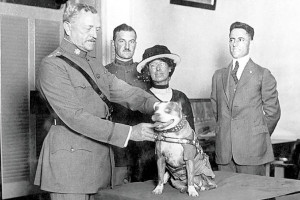
Gen. John Pershing awards Sgt. Stubby with a gold medal in 1921. Stubby served in 17 battles and fought in four major allied offensives during WWI. PHOTO: SMITHSONIAN INSTITUTION’S NATIONAL MUSEUM OF AMERICAN HISTORY
One of the most popular monuments to animal bravery can be found in New York City’s Central Park. A little north of the Children’s Zoo, the statue of a Siberian husky named Balto stands at attention on a granite rock. In February 1925 Balto led the final team of sled dogs that battled through 674 miles of snow and ice to bring diphtheria serum to the stricken children of Nome, Alaska.
The statue is a reminder of the debt of gratitude that we owe not just to the brave dogs that helped to save a town’s children but to all of the animals that have served humankind or given their lives for us.
For most of history, humans blithely ignored that debt. There is, for example, the Homeric story of Odysseus coming home after 20 years to find that no one had bothered to care for his faithful dog, Argos. And in Shakespeare’s “A Midsummer Night’s Dream,” we find the lovesick Helena crying to Demetrius, “Use me but as your spaniel—spurn me, strike me, / Neglect me, lose me,” all of which rather aptly sums up the Elizabethan attitude to Man’s Best Friend. Continue reading…





